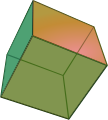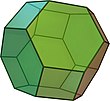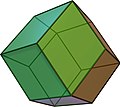Room filling
Room filling or tiling of three-dimensional space refers to the filling of (usually) 3-dimensional Euclidean spaces with structures that have at most the same dimensions as this space. For the two-dimensional case of tiling, see tiling . Space fills can trivially be complete, i.e. H. the entire volume is occupied (as with a completely filled glass), or partially, which leads to the interesting problem of spatially closest packing of spheres . In many practical applications there is an interest in optimizing the density of the filling, for example in thePackaging industry . Room fillings mathematically abstracted can be found u. a. for the space-filling curves , where fractal structures with a fractional dimension smaller than the space dimension n and larger than n − 1 are used for filling. Natural quasi-fractals of this type are often found as supply networks in biological organisms ( blood vessel system , tracheal system ).
Space filling with polyhedra
A gapless space filling with polyhedra is also called tiling of the three-dimensional space . If one tries to fill the space with polyhedra of one kind, there are exactly five of the convex polyhedra bounded by regular polygons that fill the space alone: cube , triangular and hexagonal prism , truncated octahedron and the twisted double wedge ( Johnson body J 26 , also Gyrobifastigium ). The latter four contain two types of polygons with different numbers of corners. Among the so-called Catalan solids , only the rhombic dodecahedron is space-filling.
In 1885, Evgraf Stepanowitsch Fjodorow classified the space-filling parallelohedra, i.e. polyhedra that can be converted into one another by translation ( affine types of convex parallelohedra ) and found five in three-dimensional space: parallelepiped , hexagonal prism , rhombic dodecahedron , elongated rhombic dodecahedron and truncated octahedron . This became important for his classification of crystallographic space groups.
Crystallographic restriction
An interesting phenomenon occurs with periodic tiling: their symmetry groups can only contain rotations of 360 °, 180 °, 120 °, 90 ° and / or 60 ° (i.e. elements of orders 1, 2, 3, 4 and 6), but none Rotations by other angles (ie no elements of orders 5, 7 or higher). This fact, which, by the way, also applies to “real” crystals , is called “crystallographic restriction”. However, order 5 is possible with quasicrystals that have an “almost” periodic division.
Types of 3D tiling
The following are examples of how the three-dimensional space can be completely filled with regular or semi-regular polyhedra of the same edge length. The number of polyhedra that is required to form a full solid angle of 4π is given.
- 8 tetrahedron + 6 octahedron ( picture )
- 8 dice ( picture )
- 6 truncated tetrahedra + 2 tetrahedra ( picture )
- 6 rhombic dodecahedron ( picture )
- 4 cuboctahedron + 2 octahedron ( picture )
- 4 truncated hexahedra + 1 octahedron (see fig. Right)
- 4 truncated octahedra ( image )
- 4 rhombic dodecahedron ( picture )
- 3 diamond cuboctahedron + 1 cube + 1 tetrahedron ( picture )
- 2 diamond cuboctahedron + 2 cubes + 1 cuboctahedron ( picture )
- 2 truncated octahedra + 2 truncated tetrahedra + 1 cuboctahedron ( picture )
- 2 truncated cuboctahedra + 1 truncated octahedron + 1 cube ( picture )
See also
Individual evidence
- ↑ Eberhard Scholz, Symmetrie, Gruppe, Dualität, Birkhäuser 1989, p. 117






